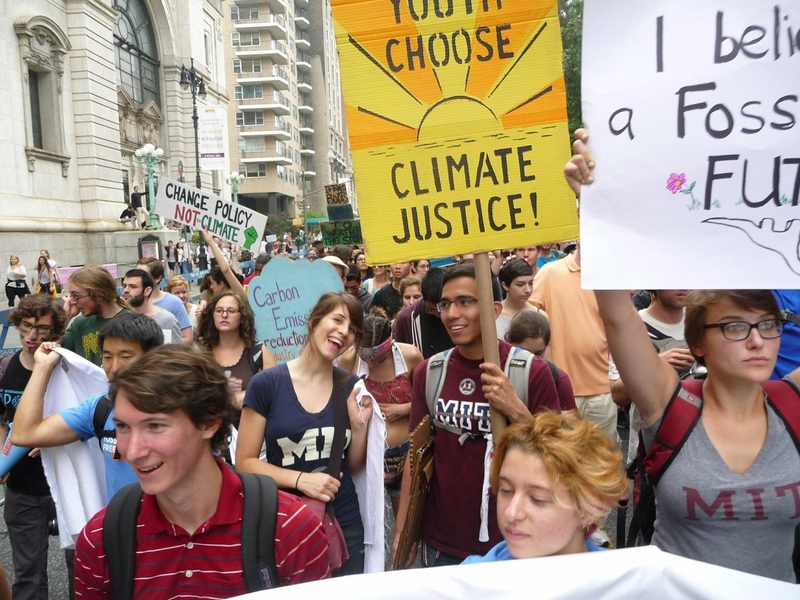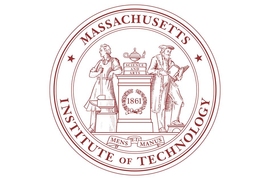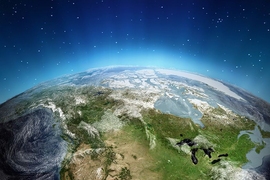Sunday’s People’s Climate March, which drew nearly 400,000 people to the streets of New York City, became the largest climate rally in history. At 2:30 p.m., amidst whistling, drumming, and chanting, a crowd of people crossed the march’s endpoint at 34th Street and 11th Avenue waving giant banners that read, “MIT for climate action” and “Fossil Free MIT.” In all, about 70 MIT students, researchers, and alumni took the opportunity to publicly demand action to combat the unchecked use of fossil fuels.
Their reasons for marching run deep. “As most of my colleagues in science, I used to be shy and disliked to protest in the streets,” says Emmanuel Vincent, a postdoctoral researcher in MIT’s Department of Earth, Atmospheric, and Planetary Sciences (EAPS). “I now think we know enough to speak up and support action to prevent climate risks. If scientists want the right political decisions to be taken in the future, they have to get involved with interested citizens and share more of their expertise with active citizens.”
The scientific case for climate action has existed in publications since the 1970s, such as the Intergovernmental Panel on Climate Change reports. Now, some 97 percent of the world’s scientists embrace the position that greenhouse gases, released from the burning of fossil fuels, trap heat in the atmosphere and oceans, which in turn leads to sea level rise, increased extreme weather events, and degradation of polar environments, among other impacts. Unfortunately, atmospheric concentrations of carbon dioxide topped 400 parts-per-million for the first time in human history last year, with no sign of decreasing.
The general sentiment among researchers at the march is that meaningful climate action requires a powerful social movement. “The world is still sitting on abundant reserves of coal, gas, and other fossil fuels,” says Brian Rose PhD '10, an assistant professor in atmospheric and environmental sciences at the State Univeristy of New York at Albany. “The cost of these fuels is still artificially cheap because we continue to use the atmosphere as a free open sewer. Business-as-usual is likely to push us toward a future like RCP8.5. This is genuinely scary — a planet I barely recognize. But it’s become very clear that nothing much will happen to avoid this future, unless we collectively start making a whole lot more noise. That’s why I attended the march, and it was amazing to see the sheer number of people who came out on Sunday. One march is not going to change the world, but it felt like the start of larger movement.”
Geoffrey Supran, a graduate student in the Organic and Nanostructured Electronics Laboratory at MIT who works to make better solar cells, served as a security marshal and peacekeeper at the front lines of the march. “We marched hand-in-hand as the bow of this 400,000-person strong ship, pushing gently through an endless sea of photographers and journalists,” he says. “Occasionally, I would sneak a peak behind me, struggling to comprehend the four miles of energy and enthusiasm that followed behind us.”
Supran, a leading member of Fossil Free MIT, a campus group calling for MIT to divest of its $12.4 billion endowment from the fossil fuel industry, says he feels a moral imperative as a scientist to participate in the march: “In my view, scientists must stand up for climate change action not only because they will be central to its fruition and success, but because it is an abrogation of their responsibility to society to not do so. Scientists wield megaphones to public opinion and an immense capacity to effect change. We must shout through them if we are ever to see our technologies make it out of the lab and into the real world, where they can make a difference. Scientists are citizens, too, and, as Michael Mann has pointed out, we cannot and should not check our science at the door of a city hall or a climate change march. What good is a debate about the future of our civilization if it is not informed by those who understand the climate crisis best?”
This event was especially significant for Supran, considering that while sitting on the bus from Boston to Manhattan, he got the news that MIT Vice President Maria Zuber publicly launched MIT’s campus-wide Climate Change Conversation, a panel of MIT faculty and students that will explore pathways to effective climate change mitigation, through education, research and campus engagement — and that Supran himself was named as one of its steering committee members.
The MIT contingent returned home encouraged and impressed. Morgan O’Neill, an EAPS graduate student who studies the dynamics of severe weather, says: “The climate march was breathtakingly diverse. I must have seen a 100-year age range, and people of every race and ethnicity. There were schools at all levels, and labor groups, and scientists, and thousands of local activist groups with various environmental concerns. Climate change affects everyone, and Sunday was a beautiful demonstration for global action. Certainly, while Americans are already impacted by climate change, our challenges pale in comparison to those in poorer and low-lying countries. They will bear the brunt of the negative impacts as rich, industrialized countries haggle over treaty wordings and blame. I’m proud to see so many Americans rallying on behalf of those who can’t.”
“It was heartening to see so many young people there,” says Alexi Arango PhD ’10, an assistant professor of physics at Mount Holyoke College. “It is mind-boggling that citizens have to go to the streets to urge our political leaders to practice common sense — to stop ignoring climate change — but I feel strongly that all of us at the People’s Climate March made a small, but important difference.”
During the march, complete strangers interested to speak with a MIT climate scientist approached Emmanuel Vincent. One of them, a self-identified climate skeptic, asked dozens of questions, which Vincent tried to answer as fairly as possible. “I asked him why he came to the march, and he said he was just curious. I thought this was encouraging,” says Vincent. Another person turned around and said, “We need to know scientists from MIT are with us and will help us in making the right choices.”








